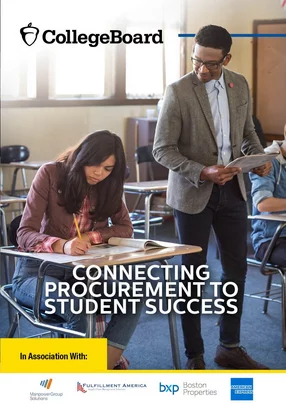How the College Board reinvigorated its procurement function to clear a path for students
As a not-for-profit mission driven organization focused on connecting more than 7mn students to college success and opportunity, one could be forgiven for asking the question as to how a procurement function can not only support but drive that mission further?
At the College Board, which each year helps millions of students across the U.S. prepare for the successful transition to college through the SAT, Advanced Placement and other programs and services, procurement is very much a key component towards delivering on the organization’s promise.
Heading up the procurement function is Steve Hughes, Chief Procurement Officer at the College Board. Having forged a career in procurement that spanned a number of for-profit organizations such as the Comcast Corporation and Vertis Communications, Hughes first entered the not-for profit space with the National Geographic Society.
It was this experience, working for a mission-driven organization such as National Geographic, that really opened his eyes to seeing just how procurement can enable opportunity to better deliver on that mission.
In 2016, Hughes joined the College Board and he immediately began to recognize the synergy between his previous role and that of the one he was about to embark on.
“It’s interesting because, at both Nat Geo and here at the College Board I was hired by someone who understood the benefits of bringing best business practices from for-profit organizations into the not-for-profit space.”
As CPO, Hughes works directly with the College Board to align a procurement strategy and the procurement function with that broader organizational goal of delivering educational opportunities for students.
Student experience and procurement aren’t exactly two areas that walk hand in hand but for Hughes, he feels that the role that procurement can and will continue to play is actually much clearer to see.
“The role that procurement can play manifests itself in a number of different ways, but it boils down to one driving principle and that is the idea of applying best practices for stewardship of an organization’s limited resources,” he says.
“We go to great lengths to ensure that the additional value procurement can bring through strategic sourcing, contract negotiations and supplier relationship management, frees up additional resources that can be invested back into providing additional opportunities for students, such as exam fee reductions for low-income students. That’s the mission.”
The very nature of procurement is changing. Where once it was assumed as a compliance function that would support the business needs on a purely indirect level, over the last decade more and more organizations have begun to invest more in procurement to the point where procurement itself can influence strategic thinking.
Hughes agrees as such. When he first arrived at the College Board, he was faced with a procurement function that he describes as primarily tactical. The emphasis of the organization’s procurement was based on processing paperwork, i.e. purchase orders and contracts.
During the two years Hughes has been with the organization, he has embarked on a journey of changing the perspective of what procurement can do for the College Board to a strategic role.
“Procurement can be a window into the marketplace to ensure that we are optimizing the value from the relationships we have with our external suppliers and internal stakeholders. Ultimately, we want to ensure those relationships are leveraged to the greatest advantage of college board through either vendor consolidation, focusing on category management.
“The results so far have shown that we been able to drive savings for the organization, and we can bring business and market intelligence to our stakeholders that create better opportunities when working with suppliers.”
It is through a refocused approach to working with suppliers that has been one of the biggest components of the procurement transformation. Prior to Hughes’s transformation mission, the “tactical” approach to procurement saw a large portion of the existing procurement team spend limited time negotiating with and establishing relationships with suppliers and more time spent pushing paperwork through systems.
Upon seeing this, Hughes kickstarted this transformation by reorganizing both the department and the way in which the people in procurement worked. Hughes wanted to transition the focus from a transaction by transaction basis to a category management approach, with sourcing team members assigned specific categories that they are responsible for across the entire organization. We reorganized the procurement team by shifting resources out of the operations side over into the sourcing side, providing us with greater bandwidth to handle more sourcing events. We also trained the people who had not been exposed to sourcing and category management,” says Hughes.
Naturally any transformation, particularly one that looks to redefine the expectations and demands of a role, will bring with it challenges Sometimes change can be difficult.
But for Hughes, his ideas were met with incredible enthusiasm both by his procurement team and by the College Board’s leadership team.
“For some people, their job wasn’t challenging them enough and this in turn meant that they didn’t really see the strategic value that procurement could have on the organization,” he says.
“As part of this journey my team has become more engaged at the start of the procurement process and working with stakeholders from the beginning, when project requirements are being defined, right through to the end, when contracts are negotiated and executed. This has empowered them and provided them with a sense of perspective as to what the true value of procurement can and will be going forward.”
As is often the case, a function is defined by its people and processes. Hughes has already worked extensively on the people element, one that can easily be overlooked in the search for greater efficiencies but running alongside this is the process and technology side of procurement.
“To put it simply, it’s about providing my team with better tools in order to be more effective and efficient,” says Hughes. “That in turn feeds into the wider goal of making procurement more valued by the organization and more effective in how we can deliver results and savings.” Hughes has already started implementing a new digital procurement suite of tools from Zycus that includes spend analytics as well as e-sourcing, procure-to-pay (P2P) and contract management, that will all be fully integrated when they go live before the end of 2018.
If a procurement function is defined on an internal level by the people and the process, then the role it plays externally is equally as important. After all, what use is a procurement function without a network of suppliers?
This notion is only magnified in the non-profit sector, as Hughes himself admits that in some instances organizations are sometimes “married” to their incumbent suppliers.
“Why change when stakeholders are happy with the service they are receiving and the price they are paying,” says Hughes.
“So, one of my challenges was to convince people that we should look at the marketplace again and determine whether these suppliers are in fact competitive with other options available to us. Often they are not.”
Hughes stresses that this was not a process of replacing vendors but rather re-evaluating those supplier relationships in order to identify opportunities for better or more cost-effective service.
See also:
- Why Kuhn Krause believes the agricultural sector fertile ground for digitisation
- How Rodan + Fields is transforming its global supply chain
- How Sydney Motorway Corporation is leveraging technology to deliver vital infrastructure projects
The ultimate message, for Hughes, is one of greater collaboration moving forward.
“We aren’t here to disrupt existing processes or relationships,” he says. “We are here to extract as much value as possible and ensure our supplier base understands that procurement is now part of the value equation at the College Board.”
Empowered by ManpowerGroup and TAPFIN MSP
Since 2009, The College Board has partnered with ManpowerGroup’s TAPFIN MSP team, which has provided The College Board an enterprise-wide contingent workforce management solution throughout the continental United States and Puerto Rico.
The program encompasses all contingent labor management, Statement of Work and Independent Contractor Management.
It is a key example of how The College Board leverages its key suppliers in order to extract as much value as possible.
TAPFIN delivers outstanding results through the use of its proprietary commercial VMS technology, Econometrix, which provides robust full-service VMS functionality in an intuitive easy to use format.
TAPFIN attributes much of its successes as a strategic partner and trusted advisor, especially during the business transformation at The College Board, to the relationships and sponsorship provided, specifically Steve Hughes. Steve has been the executive sponsor since 2016, and has been an integral part of the program’s recent expansion.
Two years in, this is still very much the beginning of the transformational journey for Hughes and the College Board. While there already has been a number of notable changes and turning points for the organization, no journey like this can ever truly end.
The procurement industry is changing and be it for-profit or not-for-profit, organizations such as the College Board have to continue to evolve and adapt in order to succeed in its mission.
Hughes recognizes as much and he himself admits that the successes that he has overseen to date are in fact only gateways into future opportunity.
“There will most definitely be lots of work and lots of opportunities that these new tools and new processes, and this newly energized team, will be able to tackle in the future,” he says. “Technology will continue to change and so we must continue to change with it.
“But, ultimately, in the future I want us to continue to enjoy great success in leveraging our value that we bring to the organization. I want our status as a business partner to continue to rise and that we will have more opportunities to engage in a larger sphere of the organization’s addressable spend.
“I have the greatest of confidence in my team to achieve and exceed the College Board’s expectations of procurement.”




